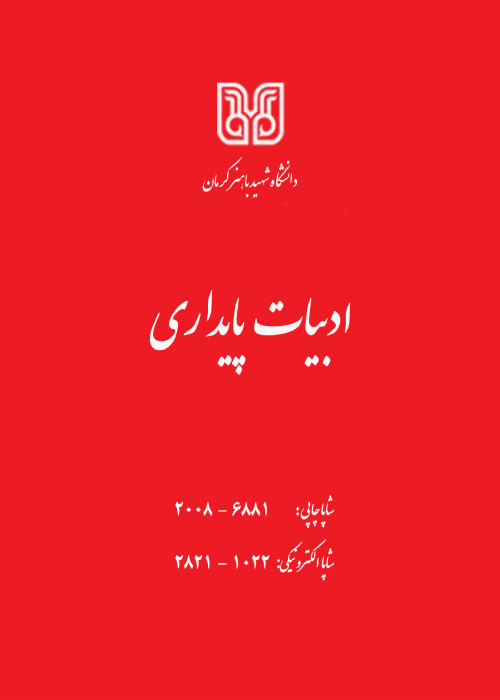Literary Coding in the Correspondence of the Freed Prisoners of the Holy Defence
Resistance literature is rooted in history. Wherever there is oppression, literature of resistance has sprouted in the form of one of the literary types. In Iran, this literature has always received attention, and, especially after the victory of the Islamic Revolution in 1357, and during the eight-year war with the neighboring country, it increased and was favored by Iranians.Although prison literature, as a type of the subset of resistance literature, ows part of its existence to the prisons of the Pahlavi regime, its colorful and main part was born in the prisons of Iraq. The letters exchanged between Iranian war-prisoners and their families are part of this captivity literature.For Iranian prisoners, who were in captivity from two to ten years, there was no other way of communication than the two special letters delivered to them at the beginning or end of each month, or sometimes every two to three months. Once given to them. Obviously, in those few pages, a prisoner had to share important information with his family and write about his situation, and, in return, the family of the prisoner had to write back about the life of the family, the city and the country, and their friends to reduce the pain of his exile. In such limited and difficult conditions, and in such a small space of writing, half of which should be left empty for the recipient of the letter, a stream of literature-in-captivity was formed and those few pages were able to record a large part of prison-literature."From the beginning of 1359, when the first letters of Iranian prisoners of the Iran-Iraq war were received by their families, until August 1369, when the great exchange of prisoners began, within these ten years, that is, from the beginning of the war to the great freedom, we in the Office of the Missing Soldiers and Prisoners of War, exchanged about six million letters from both sides, and this was when almost half of our 40,000 prisoners were registered, and we learned about the presence of the rest of the prisoners in captivity only when they were released. And these letters were exchanged under the strictest limitations and different excuses of the Iraqis" (Afraz, 2019).The history of letter writing in Iran dates back to the Achaemenid period; at that time, words were written in cuneiform on the tanned skin of animals, and the skin was given to a chapar (mailman/messenger) to carry it to its destination. Of course, in the BCE history, writing was not used except in government offices and courts. 1800 years ago, when paper was made by the Chinese, letter writing on paper and book writing appeared, and letter writing became much easier (cf.: Amini, 1379: 43). In the history of Herodotus it is stated: "Harpak wrote a letter to Cyrus and encouraged him to fight with Astyaks (Korush's maternal grandfather) and in order for the letter to easily pass through the Medes and reach Persia, Harpak put it in the belly of a rabbit. He hid it and a letter carrier in hunter's clothes was able to deliver it to Cyrus. In the Torah, a letter and a decree from Cyrus about rebuilding the building of Jerusalem - which was destroyed by the Chaldean victory - is mentioned" (ibid.).The oldest work in Pahlavi language on the art of corresponndence is the small letter "Ayin Nama-Novisi". "This book contains special examples of correspondence in various cases and to various people. This text has forty-five paragraphs, each of which presents different methods in letter writing style. The first paragraph is an introduction in the description of those to whom the letter is written. In other paragraphs, the way of writing different types of praise, address, heading and title of a letter, sympathy and consolation, and how to start and finish a letter are mentioned (Mehdizadeh, 2012).
In 1387, the author of the present study took part in the national plan for collecting letters from Iranian ex-prisoners of war carried out by the Office of Resistance Literature and Art in Hozeh Honari, and collected more than 1500 letters from Kerman province; nearly 8000 letters by prisoners from other provinces was also collected and effort was made to determine those letters with coded messeges. The research method in this study is mainly based on analyzing collected letters, and memoirs of the ex-prisoners.
The contents expressed in the prisoners' letters were important and sometimes included war secrets, that is why it was tried to express these contents in code and in literary language, and these codes were revealed only between the writer and the reader.One type of literary arrangement that the writers of letters have used a lot to express secret content was simile, because the simile was understood only by the reader and the writer, and others did not know about it.Another type of literary figure that is used to express secret content in prisoners' letters is metaphor. Metaphor has been defined as "the use of a word in its non-real meaning along with the interest of similarity between the real and figurative meaning and the analogy that prevents the will of the real meaning. In fact, metaphor is a type of lexical permission whose interest is similarity, and sometimes it is interpreted as "metaphorical permission". For example, someone who has seen a brave man in school says “I saw a lion in school.” Lion hasbeen used in the meaning of a brave man, and the speaker actually has seen a similarity between the vehicl (lion) and its tenor (brave man), and has established communication (Hashmi, 2011: 1/258).Sometimes, in the structure of some letters, especially coded letters, an equivoque was used to express the purpose; the writers could use it, hidden from the eyes of the enemy, to explain things to their audience in a coded manner in order for the secret content about the war to be protected and the desired messages to be transmitted easily. Equivoque is the use a word with more than one meaning in poetry and prose, some of whose meanings are close to the mind, and some are detached.In captivity, to have a photo of Imam Khomeini or the officials of the Islamic Republic was considered as a crime. Correspondence with these people also had bad consequences for the prisoner, and if the enemy noticed a letter written by a prisoner, his first impression was that the writer of the letter was probably a prominent soldier who had been hiding his rank. Therefore, some prisoners accepted the risk and started writing letters with tricks such as using code words instead of the name of the official. During the years of captivity, some of the prisoners, as mentioned, wrote letters to the officials of the Islamic Republic and received answers. Imam Khomeini, may God bless him and grant him peace, Mr. Khamenei, Rafsanjani, Meshkini and some other officials were among the people who answered the letters of the prisoners, and these answers encouraged and created morale among the prisoners.One of the most important issues that had to be expressed in code language was the communication of war news and secrets. If these news were revealed to the enemy, it would result in the worst torture for the prisoners, and on the other hand, it would cause their army's plan to be turned upside down and lead to their defeat.
Coded letters showed that: 1. Literary language can be most useful in expressing content and news when necessary. 2. Forcing prisoners to write coded letters reveals the dire conditions of captivity and the filth of the Baathist regime and the hypocrites. 3. In secret letters, simile has been used the most because of its simplicity and its familiarity for the author and the reader, and equivoque has had the least use in these types of letters due to its ambiguity for the reader. 4. The simplicity and intimacy of the letters and the fact that most of them are devoid of literary language indicate the level of literacy of the letter writers at the high school level. 5. Most of the topics and content of the encrypted letters followed the same line, including issues such as politics, mentioning the names of the officials of the army, Basij and Sepah, family news, war secrets, and the pains of exile.The most repeated subject was mentioning the names of the officials of the Islamic Republic, especially Imam Khomeini. 6. Much of the sensitive content of the news and war secrets has been conveyed through pun, which shows the utmost cleverness of the Iranian prisoners. Contrary to the opinnion of some people who interpret literature based only on the scale of pleasure, these could confuirm the practicality of literature.
- حق عضویت دریافتی صرف حمایت از نشریات عضو و نگهداری، تکمیل و توسعه مگیران میشود.
- پرداخت حق اشتراک و دانلود مقالات اجازه بازنشر آن در سایر رسانههای چاپی و دیجیتال را به کاربر نمیدهد.



